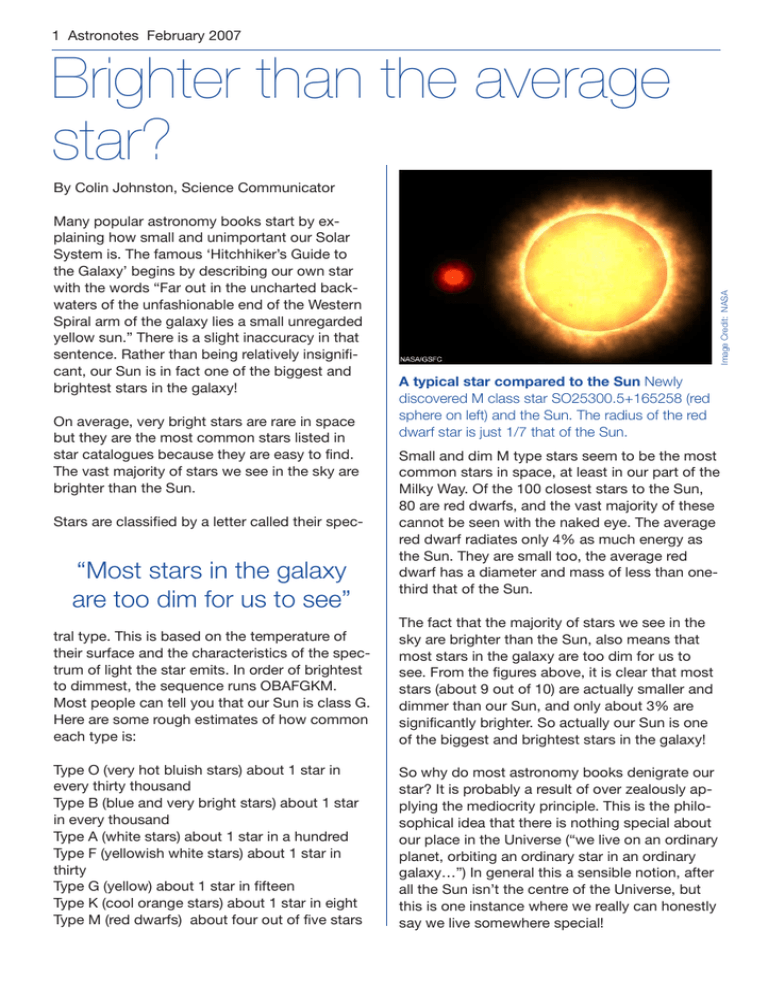Brighter than the average star?
advertisement

1 Astronotes February 2007 Brighter than the average star? Many popular astronomy books start by explaining how small and unimportant our Solar System is. The famous ‘Hitchhiker’s Guide to the Galaxy’ begins by describing our own star with the words “Far out in the uncharted backwaters of the unfashionable end of the Western Spiral arm of the galaxy lies a small unregarded yellow sun.” There is a slight inaccuracy in that sentence. Rather than being relatively insignificant, our Sun is in fact one of the biggest and brightest stars in the galaxy! On average, very bright stars are rare in space but they are the most common stars listed in star catalogues because they are easy to find. The vast majority of stars we see in the sky are brighter than the Sun. Stars are classified by a letter called their spec- “Most stars in the galaxy are too dim for us to see” Image Credit: NASA By Colin Johnston, Science Communicator A typical star compared to the Sun Newly discovered M class star SO25300.5+165258 (red sphere on left) and the Sun. The radius of the red dwarf star is just 1/7 that of the Sun. Small and dim M type stars seem to be the most common stars in space, at least in our part of the Milky Way. Of the 100 closest stars to the Sun, 80 are red dwarfs, and the vast majority of these cannot be seen with the naked eye. The average red dwarf radiates only 4% as much energy as the Sun. They are small too, the average red dwarf has a diameter and mass of less than onethird that of the Sun. tral type. This is based on the temperature of their surface and the characteristics of the spectrum of light the star emits. In order of brightest to dimmest, the sequence runs OBAFGKM. Most people can tell you that our Sun is class G. Here are some rough estimates of how common each type is: The fact that the majority of stars we see in the sky are brighter than the Sun, also means that most stars in the galaxy are too dim for us to see. From the figures above, it is clear that most stars (about 9 out of 10) are actually smaller and dimmer than our Sun, and only about 3% are significantly brighter. So actually our Sun is one of the biggest and brightest stars in the galaxy! Type O (very hot bluish stars) about 1 star in every thirty thousand Type B (blue and very bright stars) about 1 star in every thousand Type A (white stars) about 1 star in a hundred Type F (yellowish white stars) about 1 star in thirty Type G (yellow) about 1 star in fifteen Type K (cool orange stars) about 1 star in eight Type M (red dwarfs) about four out of five stars So why do most astronomy books denigrate our star? It is probably a result of over zealously applying the mediocrity principle. This is the philosophical idea that there is nothing special about our place in the Universe (“we live on an ordinary planet, orbiting an ordinary star in an ordinary galaxy…”) In general this a sensible notion, after all the Sun isn’t the centre of the Universe, but this is one instance where we really can honestly say we live somewhere special!



